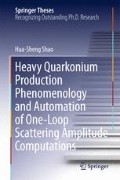Abstract
In this chapter, we describe the techniques for automatic one-loop scattering amplitude computations by using MadGraph5 [1], which is dubbed as MadLoop5 . It is an important component in the MadGraph5_aMC@NLO [2] framework. In order to avoid possible confusions between MadLoop5 and the original MadLoop4 [3], we want to emphasize here that the core functionalities relevant to the handling of tree-level amplitudes are inherited from MadGraph4 [4] in MadLoop4, whereas MadLoop5 uses MadGraph5. There are significant improvements in MadLoop5 compared to MadLoop4. Some of them are still not public.
Access this chapter
Tax calculation will be finalised at checkout
Purchases are for personal use only
Notes
- 1.
MadLoop4 is written in C++, whereas MadLoop5 is completely rewritten in Python and output in Fortran.
- 2.
I joined in the MadGraph5_aMC@NLO project from September 2012. Under ERC grant LHC theory, I stayed at CERN for one year. Since then, I am collaborating with Dr. Valentin Hirschi in developing MadLoop5.
- 3.
- 4.
We follow the notations in Ref. [2].
- 5.
The new version of FeynRules for generating NLO model will be published in the near future.
- 6.
\(G_{\mu }\) is the fermion constant.
- 7.
TIR interface is only available in the private version. It will be contained in the future release.
- 8.
It is only available in optimized mode of the private version.
- 9.
The accuracy of the coefficients \(c_j\) reported here in quadruple precision is beyond 17 digits.
- 10.
I want to thank Celine Degrande and Benjamin Fuks here for providing us the model.
References
J. Alwall, M. Herquet, F. Maltoni, O. Mattelaer, T. Stelzer, JHEP 06, 128 (2011). doi:10.1007/JHEP06(2011)128
J. Alwall, R. Frederix, S. Frixione, V. Hirschi, F. Maltoni, O. Mattelaer, H.S. Shao, T. Stelzer, P. Torrielli, M. Zaro, JHEP 07, 079 (2014). doi:10.1007/JHEP07(2014)079
V. Hirschi, R. Frederix, S. Frixione, M.V. Garzelli, F. Maltoni et al., JHEP 1105, 044 (2011). doi:10.1007/JHEP05(2011)044
J. Alwall et al., JHEP 09, 028 (2007). doi:10.1088/1126-6708/2007/09/028
H.S. Shao, Y.J. Zhang, K.T. Chao, Phys. Rev. D 84, 094021 (2011). doi:10.1103/PhysRevD.84.094021
H.S. Shao, Y.J. Zhang, K.T. Chao, JHEP 1201, 053 (2012). doi:10.1007/JHEP01(2012)053
G. ’t Hooft, M.J.G. Veltman, Nucl. Phys. B44, 189 (1972). doi:10.1016/0550-3213(72)90279-9
C. Degrande, C. Duhr, B. Fuks, D. Grellscheid, O. Mattelaer et al., Comput. Phys. Commun. 183, 1201 (2012). doi:10.1016/j.cpc.2012.01.022
S. Dittmaier, Kramer, Michael. Phys. Rev. D 65, 073007 (2002). doi:10.1103/PhysRevD.65.073007
A. Denner, Fortschr. Phys. 41, 307 (1993)
P. de Aquino, W. Link, F. Maltoni, O. Mattelaer, T. Stelzer, Comput. Phys. Commun. 183, 2254 (2012). doi:10.1016/j.cpc.2012.05.004
A. van Hameren, C. Papadopoulos, R. Pittau, JHEP 0909, 106 (2009). doi:10.1088/1126-6708/2009/09/106
V. Hirschi, Automation of one-loop computations for scattering amplitudes and applications to collider phenomenology. Ph.D. thesis, Ecole Polytechnique Federale de Lausanne (2013). http://infoscience.epfl.ch/record/186388/files/EPFL_TH5736.pdf
G. Ossola, C.G. Papadopoulos, R. Pittau, JHEP 03, 042 (2008). doi:10.1088/1126-6708/2008/03/042
V. Yundin, Massive loop corrections for collider physics. Ph.D. thesis, Humboldt-Universitat zu Berlin (2012). http://edoc.hu-berlin.de/docviews/abstract.php?id=39163
J. Fleischer, T. Riemann, V. Yundin, PoS LL2012, 020 (2012)
H.S. Shao, unpublished
A. Denner, S. Dittmaier, M. Roth, L.H. Wieders, Nucl. Phys. B 724, 247 (2005). doi:10.1016/j.nuclphysb.2005.06.033
F. Cascioli, P. Maierhofer, S. Pozzorini, Phys. Rev. Lett. 108, 111601 (2012). doi:10.1103/PhysRevLett.108.111601
R. Pittau, Comput. Phys. Commun. 181, 1941 (2010). doi:10.1016/j.cpc.2010.09.013
R.K. Ellis, J. Sexton, Nucl. Phys. B 269, 445 (1986). doi:10.1016/0550-3213(86)90232-4
R. Kleiss, W. Stirling, S. Ellis, Comput. Phys. Commun. 40, 359 (1986). doi:10.1016/0010-4655(86)90119-0
R. Frederix, S. Frixione, F. Maltoni, T. Stelzer, JHEP 0910, 003 (2009). doi:10.1088/1126-6708/2009/10/003
W. Beenakker, S. Dittmaier, M. Kramer, B. Plumper, M. Spira et al., Nucl. Phys. B 653, 151 (2003). doi:10.1016/S0550-3213(03)00044-0
Author information
Authors and Affiliations
Corresponding author
Rights and permissions
Copyright information
© 2016 Springer Science+Business Media Singapore
About this chapter
Cite this chapter
Shao, HS. (2016). MadLoop5. In: Heavy Quarkonium Production Phenomenology and Automation of One-Loop Scattering Amplitude Computations. Springer Theses. Springer, Singapore. https://doi.org/10.1007/978-981-10-1624-0_9
Download citation
DOI: https://doi.org/10.1007/978-981-10-1624-0_9
Published:
Publisher Name: Springer, Singapore
Print ISBN: 978-981-10-1623-3
Online ISBN: 978-981-10-1624-0
eBook Packages: Physics and AstronomyPhysics and Astronomy (R0)

